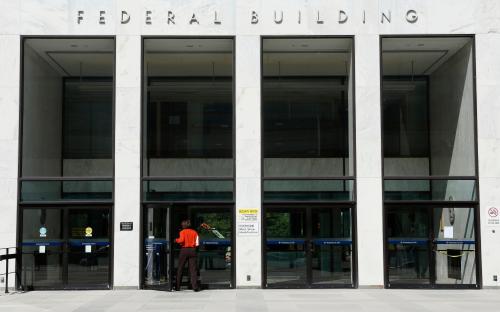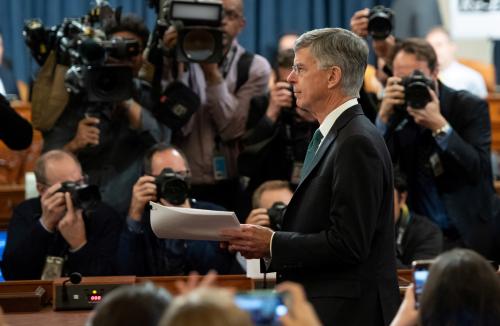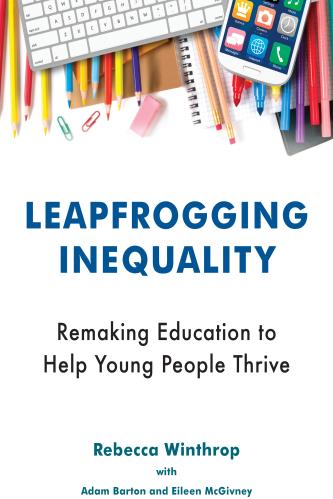The Vitals
Popular appreciation of and respect for government service and public servants have steadily declined in the United States since the 1960s, with only two brief exceptions: in the 1990s during the Clinton administration, and in the months immediately after the 9/11 terrorist attacks. There is a particularly deep sense of distrust in the U.S. federal government. In an April 2019 Pew Research Center poll, for example, only 17% of respondents indicated that they trusted the federal government “to do the right thing.” Why is this the case?
-
Across the U.S., nearly 24 million people—a little over 15% of the workforce—are involved in military, public, and national service at the local, state and federal levels.
-
Contrary to popular belief, the size of the federal government proportionate to the total U.S. population has significantly decreased over the last 50 years.
-
One third of the federal workforce will be eligible to retire between now and 2025.
A Closer Look
While there is significant support for the vital functions public servants perform at the local and state levels, and during crises, deeply entrenched misconceptions about the U.S. federal government and its individual agencies shape more negative views. For example, the opinion that the U.S. government is vast and unwieldly is widespread outside the public sector. The U.S. population has been evenly split for several years in its views on the optimal size of the U.S. government—with 47% of those polled by Pew in 2019 seeing government as either too big or too small. The two perspectives reveal a sharp partisan divide. Sixty-seven percent of those who affiliate with the Democratic Party express support for the expansion of government services. On the “too big” side of the ledger, 74% of those who describe themselves as Republicans want to see the government shrink in both size and functions. Newspaper and opinion page headlines such as “The sheer size of our government workforce is an alarming problem” encapsulate this view.
How big is the federal government, really?
The federal government attracts particular ire for its size when factoring in contract workers along with those who receive federal grants. When all of these are combined, the federal government is asserted to comprise slightly more than 9 million workers—or almost 6% of the total U.S. workforce of 156.92 million in 2019. Breaking these numbers down, and then looking at the permanent workforce in a comparative perspective, produces a more nuanced picture. As far as contract workers are concerned, these include clerical, custodial, and cafeteria staff across the entire spectrum of government agencies due to progressive outsourcing of these services. Recipients of federal grants include law enforcement, entities within state and local governments, universities and research labs, as well as nonprofit organizations and small businesses.
Across the U.S., nearly 24 million people—a little over 15% of the workforce—are involved in military, public, and national service at the local, state and federal levels. Of this number, approximately 16 million are employed in state and local governments. The federal government numbers include active duty military personnel and U.S. Postal Service workers. The U.S. military has about 1.4 million active duty service members and another 800,000 reserve forces. There are approximately 800,000 postal workers. Beyond the military and the postal service, 2 million people—just over 1% of the U.S. workforce or 0.6% of the total population—are permanently employed by the federal government. More than 70% of the federal workforce serves in defense and security agencies like the Department of Defense, the intelligence community agencies, and NASA.
Contrary to popular belief in the bloated growth of the U.S. public sector, the size of the federal government proportionate to the total U.S. population has significantly decreased over the last 50 years. It has also shrunk in absolute numbers in terms of both the full-time and part-time workforce. If we compare the size of the U.S. public sector as a percentage of the total workforce with other advanced countries, the U.S. is often smaller than its European counterparts, including the United Kingdom, although larger than Japan, which has one of the smallest public sectors internationally. In stark contrast, 40% of the workforce in Russia is employed in the public sector. In Europe, the optimal size of government is equally hotly debated, while in Russia, the size of the government and the dependency that this generates within the workforce tends to mute critical commentary.
And where do all those federal employees work?
The federal government is primarily associated with Washington, D.C., and is seen as disconnected from the rest of the country. In fact, 85% of federal government employees work outside the nation’s capital in institutions and offices across the entire country. There are federal civilian employees—not just the uniformed military and postal workers—in every state of the union dealing with healthcare, education, housing, disaster management, securing our borders, coastline and waterways, forecasting the weather, protecting and ensuring our food supply, maintaining and staffing national parks, bolstering small businesses, as well as delivering the mail. An October 2019 Pew poll showed consistently high support for the government continuing to undertake all of these functions. Other polls in 2019 recorded high levels of public anxiety about the consequences of the 2018–19 government shutdown.
Are federal employees really paid more than the average American worker?
The 2019 government shutdown—35 days from December 22, 2018 to January 25, 2019—was the longest in U.S. history. It put 800,000 employees from nine federal government departments either on furlough or compulsory work without pay. Around 4 million contractors were similarly affected. The shutdown had significant knock-on effects as federal grants, vital loans for small businesses, and Internal Revenue Service rebate checks were delayed, small companies dependent on U.S. government orders and employee patronage lost daily business, and essential employees from agencies such as the Transportation Security Administration and the U.S. Coast Guard were compelled to work without compensation. Although employees eventually received back pay, more than 60% of affected federal workers reported exhausting their savings during the shutdown—reflecting the 63% of Americans in a 2016 survey who noted that they had insufficient savings to cover a $500 emergency outside of their regular pay.
The 2018–19 shutdown underscored that the majority of U.S. federal government workers live from pay check to pay check like many other Americans. This stands in stark contrast to another set of frequent charges that public servants are part of an unaccountable privileged elite that benefits from higher wages and job security and forms an almost untouchable caste within the country. It is certainly the case that public servants are not elected and, therefore, cannot be held accountable and removed from office by voters in the same way as elected government officials. But, public sector employees are recruited on the basis of specific knowledge and expertise from the broader population. Public sector employees at the local and state levels reflect the overall American workforce. They are also subject to frequent performance reviews and formal oversight.
The data does show a different picture for the 2 million federal government employees outside of the military and postal service, and here there is grounds for criticism. Because of the nature of their jobs in highly-skilled professional and administrative positions and the specific qualifications required to perform them, according to figures from 2018, 70% of public servants in the federal government were more likely than the rest of the U.S. labor force to have a bachelor’s or advanced degree—47.7% to 41%. Those in the top government salary brackets (the GS, or General Schedule, pay scale) also seem to benefit from “grade inflation” in their annual performance reviews, which would indeed raise the bar for holding them accountable and removing them from office. In a 2016 report, the federal government’s own oversight body, the Government Accountability Office (GAO), criticized the conduct of reviews and performance scores for this group. The GAO called for reforms that would enable the federal government to weed out poor performers.
Similar to members of the U.S. military, federal government professionals and administrators form a standing force, a permanent cadre of experts that maintains the continuity of core U.S. government operations and functions through successive changes in administration. Within the permanent cadre of the government, just over 7,000 employees form the Senior Executive Service (SES). The location and composition of this group of senior executives also bear out some of the more pointed critiques of the federal government. Although this is a mere 0.35% of the total federal workforce, the SES is primarily (70% of employees) located in the Washington, D.C., region (including Maryland and Virginia). As a group, the SES is far less diverse than the rest of the federal government, as well as the U.S. workforce as a whole. In fact, the diversity of the federal workforce, particularly in terms of race and ethnicity, diminishes sharply beyond the entry-level pay grades. About 37% of the overall federal workforce identifies as a minority, which drops to around 20% in the SES. Women represent less than 43% of all federal employees in contrast with 47% of the overall U.S. workforce.
What are the most pressing issues to tackle?
As the United States contemplates the devastating economic and social effects of the COVID-19 pandemic, on top of the public health impact, we face the dilemma of how to reopen and rebuild. In extremis, the federal government has expanded its role in shoring up the economy since March 2020, but restoring trust in the federal government and increasing interest in public service remain significant challenges. This is a pressing problem because the federal workforce is aging rapidly. One third will be eligible to retire between now and 2025, and only 6% of federal employees are under 30 years old. Government service has never ranked among the top job choices for college graduates. Between 2001 and 2017, the percentage who entered the federal government, from the overall pool who opted for a government job, decreased from nearly 75% to 25%. This means that more college graduates are seeking employment at the state and local government levels. Finding out about permanent federal government jobs—rather than jobs at the state and local levels—is particularly cumbersome, and often requires sifting through huge numbers of vacancies on the USAJOBS website. This is partly why government contractors have stepped in to fill many federal government positions.
The deficiencies in federal government civilian hiring stand in stark contrast with the ease of enrollment in the U.S. military, with its recruitment centers in main streets of small towns, shopping malls, airports, and frequent public advertising campaigns. The U.S. military has made considerable effort over past decades to bring women and minorities into service as well as to address problems of diversity as personnel advance through the ranks. Although the U.S. military also has more reforms to undertake, popular confidence in the military remains high. Indeed, the military now plays an important role in training and underpinning the federal workforce. After retirement, a large number of former military service members re-enter federal service as civilians. In 2017, one third of all federal employees were veterans as opposed to only 6% of the total U.S. workforce, and almost 40% of new federal government hires in that same year came from the military.
The military has historically seen a correlation between major crises and surges in unemployment and higher recruitment rates. After the terrorist attacks of 9/11, for example, the military experienced a modest but temporary bump in enrollment. COVID-19 deaths have long-outstripped the casualties of the 9/11 attacks; and given the historic unemployment rates as a result of the mass economic shutdown to combat the pandemic, there will likely be a further boost in military recruitment in the years ahead. Nonetheless, American youth with a family connection to military service are the most likely to enlist and many Americans have never considered military service. During the COVID-19 pandemic, public health has become closely linked with national security as health workers have moved to the frontlines of battling the disease. This underscores the importance of creating new U.S. government infrastructure to recruit public servants more broadly from the American population at large while the momentum is still there. This might include outreach focused on telling the personal stories and calls to duty of people who have chosen careers in public service as a result of COVID-19.
Ensuring government effectiveness and accountability at all levels is the constant preoccupation of government oversight agencies, the U.S. Congress, and even organizations like the Brookings Institution, which was first set up in 1916 as the Institute for Government Research to analyze public policy at the federal level. After every election cycle, each new U.S. administration appoints approximately 4,000 high-level political personnel to lead the permanent staff of the federal government agencies in implementing new policies. Brookings scholars have served in every successive presidential administration since Franklin Delano Roosevelt.









Commentary
Public service and the federal government
May 27, 2020